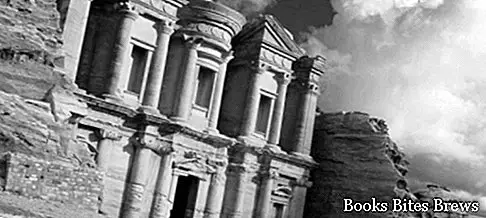What to see in Petra, where it is located, historical notes and itinerary including the main places of interest, including the interesting remains of the Byzantine Church.
Tourist information
In Jordan there is Petra, an ancient and splendid archaeological site, located halfway between the Dead Sea and the Gulf of Aqaba, 250 km south of Amman.
The city was created by digging in the rock east of the Wadi Araba, in the mountains in a place inhabited millennia before the coming of Christ.
The area was inhabited by the Edomites, a people specialized in working with ceramics, towards the end of the 6th century. B.C. the Nabataeans arrived, a nomadic Arab people who settled there gradually, enticed by the good geographical position and by the abundance of water resources in the area, obtained by recovering and ingeniously managing rainwater.
In the second century BC Petra became the capital of the Nabataean Kingdom, a large city located along the ancient incense road, a caravan route along which the trade of spices, silk, incense and exotic goods took place.
In Petra the caravans could stop and find hospitality, protection and water in exchange for a tax on goods.
With the Roman occupation, Petra experienced a remarkable development from the urbanistic point of view, but at the same time it lost importance from the commercial point of view, as the Romans took control of the routes and the caravans that stopped in Petra decreased significantly, thus point that the Nabataean people also lost power and wealth.
In the 4th century AD these events were also joined by a strong earthquake that destroyed the city and caused the beginning of a slow exodus of the inhabitants.
Some excavations have brought to light churches dating back to the fifth century, evidence of the spread of Christianity in Petra, while the Islamic conquest, which took place in the region between 629 and 632, did not particularly mark the city as it was reduced to a village isolated from the center of the power.
The area, conquered by the Frankish Crusaders, in 1187 was reconquered by the Muslims.
The city, gradually abandoned, was occupied by local Bedouins and forgotten by the western world, until its rediscovery took place on August 22, 1812 thanks to the Swiss explorer Johann Ludwig Burckhardt.
Recommended readings- Petra (Jordan): what to see
- Jordan: useful information
Petra, an extraordinary work of man and nature's ingenuity, has been declared a World Heritage Site by UNESCO.
What see
Few remains of the Byzantine Church, above which today stands a modern building.
In its original form, the church had been built by the Nabataeans, later redesigned and enlarged by the Byzantines around the year 530 AD.
It had a single nave, decorated with geometric designs and with a single entrance on the front.
Various renovations have taken place, mainly due to the damage suffered by the building during periodic earthquakes.
Thanks to an American center, specialized in studies and research on oriental religions, the church was perfectly restored.
Most of the ancient remains were reused, arranging them around a quadrangular courtyard with a perimeter formed by 12 columns and a well in the center.
On the opposite side of the entrance to the place of worship is the baptistery, on the south side of the courtyard, the floor around the altar and that of the nave is enriched with inserts of polychrome marble, while on the sides there are mosaics attributed to the Gaza school .
Six columns divide the aisles from the main nave.
The mosaic in the right nave consists of 51 medals on three rows depicting human beings and the 4 seasons.
In the left nave there are 84 medallions, where animals and plants are represented.
The papyrus of Petra was discovered in the central nave, or a series of 152 rolls of documents relating to contracts, financing and various subjects of civil interest, dating back to the administration of the sixth century.
A great historical value is attributed to this discovery as the continuation of the Nabataean culture is also proven during the Byzantine era.
The Tomb of Aaron is a small building dating back to the thirteenth century, located on the Mount of Aaron in the Shara range.
To reach this place you have to start from the lower town of Petra, walking on foot behind the Palace of the Pharaoh's Daughter and continuing straight on until the path begins.
Starting the time count from here, it should be considered a time of over 4 hours to get to the funeral monument, a little less to go back, an excursion that therefore requires a full day starting very early in the morning.




